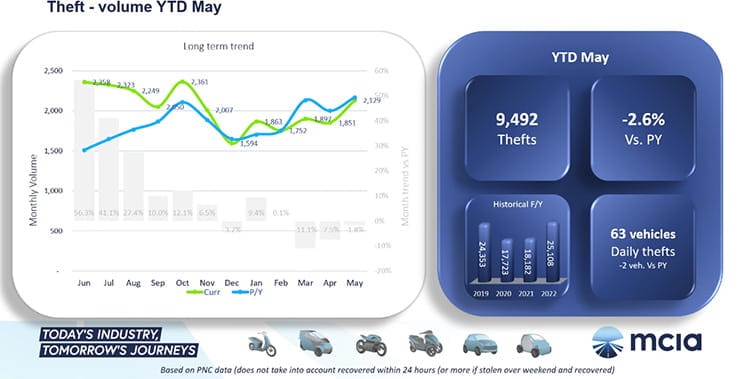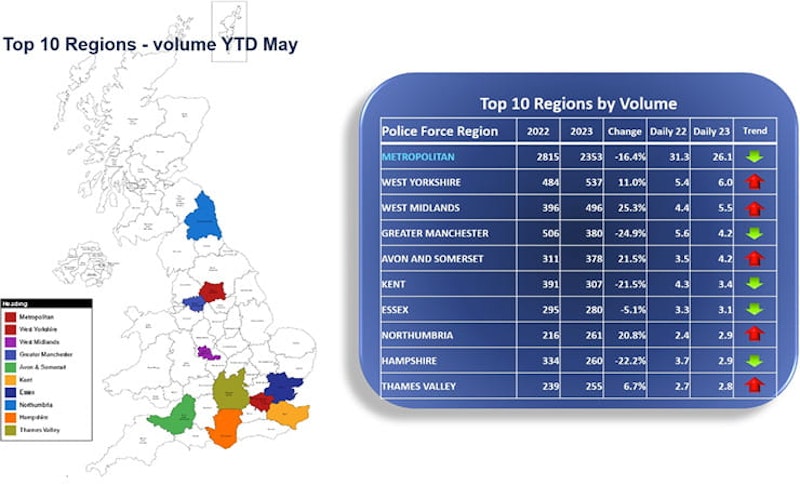Motorcycle theft is DOWN, but there’s still more to be done
By Dave Yorke
Freelance journalist
30.06.2023
Slide courtesy of MCRG, MCIA and Datatag
Motorcycle thefts are down compared to this time last year as criminals focus on more lucrative – and often easier – targets.
The year to date (YTD) figures, up to and including May2023 from the Motorcycle Crime Reduction Group (MCRG) show that there have been 9,492 powered two wheeler (PTW) thefts in the UK, which represents a 2.6% decrease against the figures in the same period for 2022.
Of those 9,492, 58% were classed as motorcycles, with the remaining 42% being scooters and quads.
In a downward trend that has seen consecutive decreases for March, April and May 2023 – when measured against the same months last year – of 11.1% 7.5% and 1.8% respectively, the figures still show that, on average, 63 PTWs a day are stolen across the UK (using the split, that’s 37 motorcycles), although that’s down on the 65 a day from last year.
That’s great news on a national level, but there are signs that bike thefts could be returning to pre-pandemic levels: in 2019 there were 24,353 thefts, followed by drops in 2020 to 17,723 and 18,192 in 2021, followed by a rise in 2022 to 25,108 thefts.
Slide courtesy of MCRG, MCIA and Datatag
Where are most motorcycles stolen from?
Although the national trend is down, where you live might be a different matter.
If you’re in London, thefts are down in the year-to-date figures, where The Metropolitan Police area showed a decrease of 16.4%, with powered two wheeler theft reduced YTD from 2,815 thefts in 2022 down to 2,353 thefts in the same period this year. That’s over five a day fewer being stolen in the Metropolitan Police area.
The figures, percentage wise, are even better in Greater Manchester, where thefts have been reduced by 24.9%, from 506 in 2022 to 380 in 2023. Remember though, that these are year to date figures up to and including May, measured against the same period last year, but the figures are down.
West Midlands police showed an increase on the YTD figures of exactly 100 PTWs, up from 396 to 496, which relates to a 25.3% rise.
Avon and Somerset Police showed a rise of 21.9%, from 311 thefts to 378.
Other police forces that showed rises in their areas included West Yorkshire Police with 537, Northumbria Police with 261 and Thames Valley Police with 255 thefts.
Slide courtesy of MCRG, MCIA and Datatag
How police forces will react to these figures
While some forces – like the Metropolitan Police – show consistently high numbers of bike thefts, that’s generally because they’re responsible for the large cities where economies of scale take place. Other forces might not have what would be described as huge numbers of thefts, but suddenly show a massive spike in relative scale.
In the YTD figures for 2022, Sussex Police showed 129 thefts, but fast forward to the same period in 2023 and they’re showing 243 thefts. That’s a whopping rise of 88.4%.
South Wales Police showed the next highest change (53.9%) with 76 PTWs stolen in the first five months of last year, rising to 117 in the same period this year, with Devon and Cornwall Police showing a similar rise of 51.3 % that related to 113 for 2022 and 171 YTD.
Police forces live and breathe these figures: every Monday morning command teams all over the country will be sitting down and pouring over what’s gone on in their area and deciding how to tackle it. They’ll do the same during the week, and figures that show an 88% rise in a particular crime should stand out like a sore thumb.
Are all the motorcycle thefts included in these figures?
No, the figures here are taken from the Police National Computer. The way the PNC is updated means that not all reported thefts will be in these figures.
If, for example, a bike is stolen and placed on the PNC but recovered and taken off before the next update it won’t be included in the recorded thefts.
It sounds a bit daft, but the figures have always been reported in this manner so do show a semblance of consistency. In my experience as a sergeant at Merseyside police, the only times a stolen bike will be taken off the PNC is if the owner recovers it themselves: a motorcycle or scooter recovered by the police should be getting an examination to confirm its true identity, and will remain listed as stolen until that identity is confirmed. It’s extremely doubtful that this would be completed within the short time frame of a PNC update.
Some bikes can find their way into Eastern Europe if not recovered quickly
How many stolen motorcycles and scooters get recovered?
The figures show that 5,983 stolen motorcycles and scooters were recovered in the YTD including May 23, which is more good news as it shows an increase of 7.4% over last year.
However, these numbers don’t show what condition the recovered bikes were in, and if all that’s brought back is a burnt-out frame that can be identified, then that’s a recovery.
In my experience, a call from a tracking company or owner to advise the police of the location of a stolen vehicle should get a response. Police officers love catching criminals in the act, and there’s no better way than following a tracker. Thieves will usually park a bike up for a while to see if it gets a response from officers following a tracker, before moving it somewhere safe to either dismantle it, or to start using it as daily run-around to commit even more crime on.
How quickly are stolen motorcycles and scooters recovered?
There are, unsurprisingly, figures for everything. A motorcycle or scooter fitted with a tracking device might get recovered straight away or relatively quickly – it will certainly have a better chance of immediate action by the police than a bike without one – but some bikes can take days, weeks, months or even years to be recovered.
The stats show us that the best forces at recovering stolen bikes take on average 12-13 days. Cheshire takes 12 days on average, with Avon and Somerset taking an average 13 days, so where Avon and Somerset Police showed a rise of 21.9% in YTD thefts, they do seem to be recovering them quickly as well.
Other police forces that recover bikes in a reasonably short time are Durham, who take an average 13 Days, while Suffolk, Bedfordshire and Cambridgeshire all average 14.
At the other end of the scale, if you live in Gwent you’ll have to wait an average 25 days, Leicestershire 28 days, Dyfed & Powys 31 days, Northern Ireland 31 days and Norfolk 39 days for your bike to be recovered. It’s worth noting though that none of the forces above feature in the areas with the highest thefts.
A recovery can be the result of anything from a bike fitted with a tracker being pounced on by the police straight away or the result of diligent work in identifying chop shops and obtaining search warrants, to a member of the public finding a bike in bushes and phoning the cops to tell them where it is. That vital link between the public and the police can be all that’s needed to fill an intelligence gap to aid more recoveries and prevent more thefts.
Remember that an average can be skewed by bikes that take years to be found… as two of the leading players in motorcycle tracking, BikeTrac and Datatool both told us that most bikes recovered using their trackers are done so within just 90 minutes of a confirmed theft.
Bennetts BikeSocial tests security kit to help you find the best
Is motorcycle theft really down?
It certainly looks that way at the moment, on a national level at least. The Metropolitan Police have seen the numbers of motorcycles and scooters stolen in their area drop by a whopping 462 in the first five months of the year, and other police forces are showing reductions as well. There’s still some work to do for some forces, but as the saying goes, crime doesn’t crack itself and we’ll look forward to the yearly figures when they are published.
How to reduce the chance of YOUR bike being stolen
Based on data from almost 200,000 riders carried out by Bennetts motorcycle insurance, using even a basic disc lock can reduce the chances of your bike being stolen by a factor of three.
Using heavy duty security at home can reduce that to less than 1 in 1,000, meaning the average family car is more likely to be stolen than a securely locked motorcycle. You can see all the data on why locking a motorcycle reduces theft here.
Decent bike security – be that a lock, alarm, tracker or other device – is an investment you should only need to make once, so buy the best you can afford, then make sure you use it. Insurance policies take many factors into account, so you won’t always see a discount for locking your bike up, but you are significantly reducing the chances of losing your pride and joy, and you’re also potentially protecting your insurance no claims discount, as well as your future policy prices.
As thieves find easier and often far more lucrative targets in bicycles and high-value cars, taking steps to secure your motorcycle or scooter DOES make a difference!
If you’d like to chat about this article or anything else biking related, join us and thousands of other riders at the Bennetts BikeSocial Facebook page.
Share on social media:

